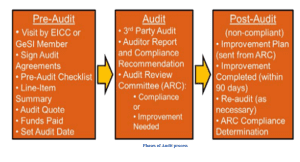Conflict minerals – Tantalum, Tin, Tungsten and Gold (3TG) – and supply chain transparency will be in the news. Monday, June 1, is the deadline for more than 6,000 Public U.S. companies to file reports with the SEC to disclose whether their products contain conflict minerals. The US passed a legislation in 2010, called “Dodd Frank Act Section 1502“, which requires US-listed companies to carry out due diligence on minerals sourced from the Democratic Republic of Congo, and neighboring countries. This legislation requires manufacturing companies to identify and disclose the conflict mineral usage in their products, and the source of 3TG to the SEC. This legislation has prompted comparable initiatives by governments in other countries and multilateral institutions.
The goal of this legislation is to reduce violence by armed groups in central Africa. Armed groups in the Democratic Republic of Congo (DRC) pursue illicit trading of conflict minerals to fund their activities. These minerals are found in abundance in the DRC. According to the United States Geological Survey, DRC contributes around 15-20 percent of world’s Tantalum production, 5 percent of world’s Tin production, 0.6 percent of Tungsten, 0.5-2 percent of Gold production.
3TG minerals are used in a variety of products but are particularly critical in the information and communications technology (ICT) industry. These minerals can be purchased from a variety of suppliers and it is very difficult for consumers to know if the product they are using has helped to fund violence.
| Minerals Extracted | Refined To | Uses |
| Columbite-tantalite (coltan) | Tantalum (Ta) | Electronic components in mobile phones, computers, digital cameras, videogame consoles. It is also an alloy used for making carbide tools and jet engine components. |
| Cassiterite | Tin (Sn) | Alloys, tin plating and solders for joining pipes and electronic circuits |
| Wolframite | Tungsten (W) | Metal wires, electrodes, and contacts in lighting, electronic, electrical, heating and welding applications |
| Gold (Au) | Making jewelry. Due to superior electric conductivity and corrosion resistance, gold is also used in electronic, communications and aerospace equipment. |
The conflict mineral supply chain is long and complex. Minerals can change ownership many times before they reach ICT manufacturers. From the mines, the minerals get transported to trading towns. The 3Ts are brought by buyer-transporters. They smuggle the minerals by large trucks, or by planes in small garbage bag type sacks. The minerals are then sorted by trading houses. These traders are paid in advance by the exporters to whom they sell the minerals.
Gold trading is a different that the because by weight, it is much more valuable. Smuggling gold is easier. It can be smuggled in backpacks or pockets whereas the 3T minerals are transported in sacks.
Since tin, tungsten, and tantalum are transported in larger volumes by trucks or planes, it is easier to register, document, and regulate the transport. But, the majority of transporters and trading houses violate of Congo’s mining laws and operate without proper licenses and registration. Partially this is because the government charges $500 for licenses, which can seem exorbitant in a poor nation. Further, traders may find it dangerous to be overly specific about the source of their minerals.
In the next part of the supply chain, export companies buy minerals from the trading houses and transporters, process the minerals using machinery, and then sell them to foreign buyers. These refining companies are mainly based in East Asia. When it comes to tracing supply chains back to their sources, refiners are the critical link. After the mineral ore is refined into metal, it becomes impossible to precisely define the source location.
Finally, the refiners sell Congo’s minerals to the electronics manufacturing companies.
There are a number of programs to help companies find conflict-free smelters. The Electronic Industry Citizenship Coalition and the Global e-Sustainability Initiative (GeSI) have launched a Conflict-Free Smelter Program to help companies source minerals responsibly. The organizations issue a list that includes the names, locations and links to conflict minerals policies of all smelters or refiners that are compliant with the Conflict-Free Smelter Program assessment protocols.
To become a compliant smelter or refiner, these companies must submit to audits. An audit is valid for one year. The audit process may take up to 6 weeks and costs about five to ten thousand US Dollars. The audit activities take place both on site and off site. At the site, the auditor takes a facility walkthrough to analyze the smelting processes, storage, receiving and shipping of minerals including a physical inventory check at their warehouses. The offsite audit mainly deals with validating of documents produced by the smelting company such as country of origin of minerals, secondary material (or as recycled or scrap materials) documentations. After the proceedings the auditor creates an audit summary report for the auditee and the CFS Program Audit Review Committee (ARC). Smelters and refiners who pass are issued a compliance letter.
Another program is run by the tin industry association, International Tin Research Institute (ITRI). This association runs a traceability initiative, ITRI Tin Supply Chain Initiative (iTSCi) that is used to monitor the origins of 3T minerals; the 3T minerals are labeled with the details of the mine they were dug from.
Some other industry specific initiatives include Tantalum-Niobium International Study Center (TIC), INTERNATIONAL TUNGSTEN INDUSTRY ASSOCIATION (ITIA), Tungsten Industry—Conflict Minerals Council (TI-CMC).
Insuring that minerals are “conflict-free” and “DRC-free” should not be confused. Simply avoiding purchasing minerals from DRC would not be responsible sourcing. DRC-free sourcing will impact poor miners adversely.



















Leave a Reply